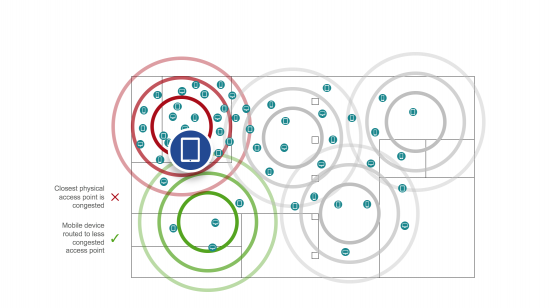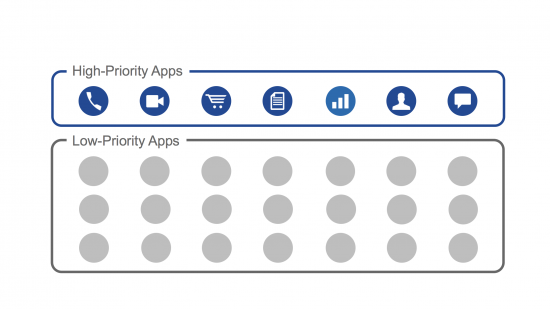































A year ago, Apple and Cisco announced a partnership to transform business through mobility. Lofty goal to be sure. Since then we've been hard at work behind the scenes. Over the summer, more than 30 customers and partners - ranging from BT (UK) and DT (Germany), to KDDI (Japan) and IAG (Australia) - participated in early field trials to help us refine our solution.
As the head of engineering for enterprise networking at Cisco, I'm especially proud of what my team has accomplished. We've worked together with Apple so that with iOS 10, iOS devices and Cisco network can recognize each other, similar to a handshake, which then turns on Wi-Fi optimization and prioritization for business critical apps. (The third iOS 10 feature enables Cisco Spark to provide a first-class voice and video calling experience on iOS devices. and Jonathan Rosenberg goes into details here).
So let's get into the details. What exactly have we been up to over the last year.
Optimizing Wi-Fi connectivity:
Our challenge was to deliver intelligent and efficient roaming for iOS devices, giving apps the best connection. And that's exactly what we've done. Let me explain.
Let's say you connect your iPad to the Wi-Fi network, get on a WebEx meeting and start walking. On most networks, a mobile device will connect to the AP with the strongest signal. Then when the AP signal becomes too poor to maintain a connection, your mobile device will scan all channels (up to 25 of them!) in search of the next strongest signal for that SSID.

Now, as iOS devices connect to a Cisco enterprise wireless network, our AP uses 802.11k to provide a list of the top six neighboring APs. Your roaming iPhone only has to check up to six channels, saving the time and battery. Even better, as your iPhone gets to the edge of the cell, we check its location and use 802.11v to provide a short list with the next best AP, based on signal and utilization. As a result, your iPhone will connect to the less busy access point offering the best signal, maximizing the network connection speed and performance.
Finding the next AP is great, but jumping to that AP may take time if you need to negotiate security parameters. 802.11r solves that issue by providing fast security negotiation and fast roaming. The problem is that most networks do not implement 802.11r (some old devices do not react well to 802.11r, and not all networks implement new features). So we also solved that problem by enabling a sort of handshake with iOS 10 devices. We recognize each other and we turn on 802.11r selectively for your iOS 10 iPhone or iPad, even if the SSID did not explicitly enable 802.11r. That means the device will roam quickly and seamlessly from access point to access point. Apps perform faster, and VoIP calls stay on the line.
The network does the heavy lifting, configuring all these capabilities by default, making it even easier for IT to deploy advanced features.
Prioritizing business apps:
But that's just the beginning. We're also helping you prioritize apps that are most important to your business.
Business networks have a wide range of content on their networks and not all of it has the same importance. Typically, apps are given the same level of priority whether they're business apps such as voice, video conferencing, messaging, and document sharing apps - or if they're games, movies, and social media apps. As a result, apps that are important to your business end up sharing the same network resources with non-business apps, bogging down your work experience.
You can configure QoS on your infrastructure of course, and that's great, but until now you could not control the 'last mile': the link from your client to the AP. Now you can. With iOS 10, we've improved the app experience on a Cisco network to ensure that even if the wireless network is congested with different app traffic, we can use new capabilities in iOS and the Cisco Wi-Fi network to prioritize the most critical apps and data over noncritical apps.
IT managers are empowered to simply "white list" or select the apps they want to prioritize over the regular traffic with a simple configuration profile provisioned to the iOS device. When you mark apps for priority, you put the apps that are most critical for your business in the Fast lane.
When your iOS device joins a Cisco network, the AP activates the profile on the device. Apps in the Fast lane get prioritized. Even better: the profile is SSID-specific. You can have different profiles and different white lists, depending on whether you are on the office network, at school, at home, or somewhere else. For the first time, your network QoS matches the client QoS. Same view of what apps matter most, same efficiency. So when a user is on a Spark call, their conversation does not get choppy even if there is another wireless user loading the network with a non-work related video streaming app.

All just one software update away...
Sounds cool, right? And our tests reveal that once again promise meets reality. These new environments deliver the following benefits based on the internal tests that Apple and Cisco have conducted together:
For many of you all of these amazing features are just one iOS update away. Wi-Fi optimization and app prioritization are already available in Cisco AireOS WLC 8.3. Cisco Meraki started supporting these features with a new MR firmware rolled out to customers in October and November.
Sound interesting? We have some other exciting innovation in the hopper. But we'd also be interested in hearing your ideas. Pop your thoughts into the comments and I'll make sure to read them all!
 Tags chauds:
La pomme
Cisco Meraki
Spark
wi-fi optimization
iOS 10
business apps
Tags chauds:
La pomme
Cisco Meraki
Spark
wi-fi optimization
iOS 10
business apps